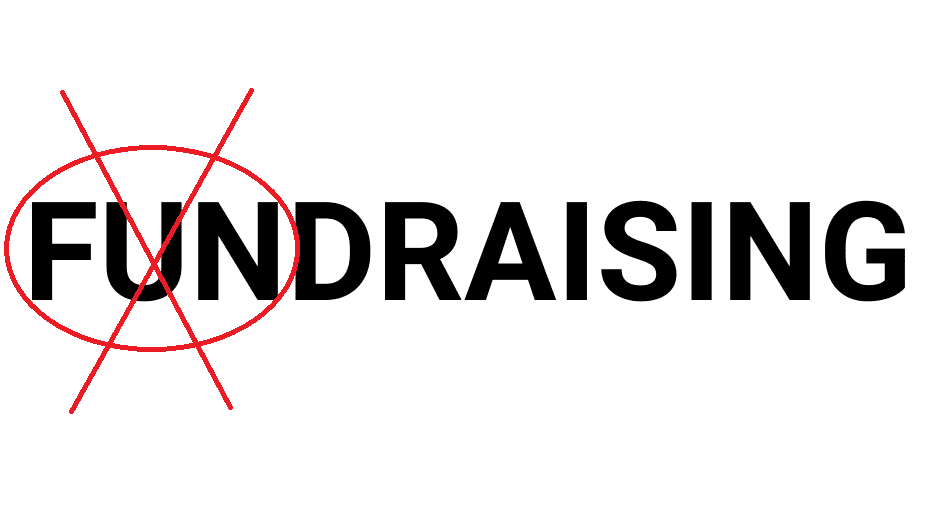Fundraising is about building relationships. Marketing provides you the tools and messaging to be able to make those connections and strengthen them.
Are your organization’s fundraising and marketing efforts converting people into donors and ambassadors for your cause?
Awareness To Advocacy
Last week I read a great post about using data to drive your social media strategy. The post includes this image which discusses your social media objectives and how you go about measuring success:

Screenshot courtesy: https://www.falcon.io/insights-hub/topics/social-media-strategy/data-driven-social-strategy/
Let’s look at each of those through a nonprofit lens and see if your marketing and fundraising efforts are paying off.
Awareness
Do people even know your organization exists?
Your team is creating real change in the community. Wonderful! But if you’re not getting the word out there, sharing the issue you advocate for, mobilizing people to take action, your organization might not survive very long.
So how do you create awareness? Here’s one way:
- Start with your team! Ask staff and volunteers to post on their social media profiles about your organization’s work. Let them share their pride in what they’re doing but also use it to educate family and friends.
- As they begin to drive traffic to your website, make sure your website is optimized for encouraging enewsletter signups. Start building your email list so you can, down the road, convert subscribers into donors. (Build relationships!)
- Additionally, use your website to make people aware of your presence on social media. Build your following on the platform/s you’re using.
Other ways to build awareness: Community events; media appearances; partnering with other local organizations; following and engaging civic leaders on social media; being present and engaging on local Facebook Groups where people are looking for solutions you can provide.
Consideration
You’ve started growing your email list and building your following on social media. Yay! But are people interested in partnering with you to solve the specific problem in their community that you advocate for?
For social media:
- Your job is to engage your followers in conversation. Posting and walking away till the next day won’t move the needle. Likes on a post matter little. What does matter is comments and shares.
- When people are responding to your posts by requesting more information, by taking action (e.g. signing up to volunteer), they are beginning to show interest in being a part of the solution.
For email:
- Sending emails with constant requests for donations is NOT how you build relationships!
- Communicate information about your organization; present data about the specific problem; share stories from service recipients and staff; use surveys to learn more about your subscribers.
- Measure: Are people clicking on your calls-to-action (CTA)? Once on the site, are they spending time on the pages you’re sending them to?
Other ways to measure consideration: More people contacting your organization to volunteer; more media requests; more organizations and people turning to you for assistance.
Purchase
Plain and simple: Are people becoming donors?
They’ve learned your organization exists (awareness). They’ve taken an action, such as clicking a CTA in your enewsletter (consideration). Are they converting from subscriber to donor?
This is the critical stage for the relationship you want to build. Because a donation is not the end of the road. It should be just the beginning.
Someone who donates for the first time has signaled their intent to you: They want to help solve the problem in their community. Your job? Let them know they’re making a difference! Your personalized thank you letter should spell out what their gift is doing. Your follow up enewsletter should provide donors a final resolution and let them know that all is good.
When a donor can see that they’re making a difference, they’re going to want to do more of the same. But that’s only if your organization continues to communicate with them on a regular basis.
Big tip: After the first donation, have your CEO or a Board member call the donor and personally thank them. Make the donor feel special. Let them feel the love. Make the donor feel like this is a partnership and they have a stake in creating a better and more equal community.

Photo by Adi Goldstein on Unsplash
Advocacy
As relationships with your donors become stronger, you want donors to eventually become “brand ambassadors.” They champion your cause to family and friends. Donors bring people to your events. They friendraise and get people to donate to your organization.
In short, they have become invested in the success of your organization and they want others to do the same.
Your job is to provide them with everything they need to spread the word. For example: A donor is running a 10K and wants to raise funds for your organization? Provide them with your logo, mission statement, suggested posts to share online, how donations will be used and anything else needed to help them reach their donation goal.
Think about the current makeup of your organization and who these ambassadors could be. They don’t always have to be donors! Board members, staff, volunteers, parents or family members of your service recipients. All of them have networks that you can tap into.
Just For A Second…
Think about the clothes you wear. You learned about company X (awareness). You started following them online and learning more about the products (consideration). Finally you decide to buy one product and take it for a test run (purchase). You love it so much that you dress yourself head to toe in that company’s gear. You take photos of your amazing outfits, share them online and tell everyone how happy you are with everything you bought (advocacy).
At this point, you have a strong connection to the company.
Your nonprofit is not a for-profit. Your service recipients are not clothes. But the path from awareness to advocacy takes a similar route.
Are you helping people move through that funnel? That’s how you ultimately measure your fundraising and marketing success.
P.S. The average retention rate in the sector? An abysmal 45%. We’re good at getting people to purchase but that’s where the relationship ends. Which is too bad because acquiring new donors costs more than retaining them.




